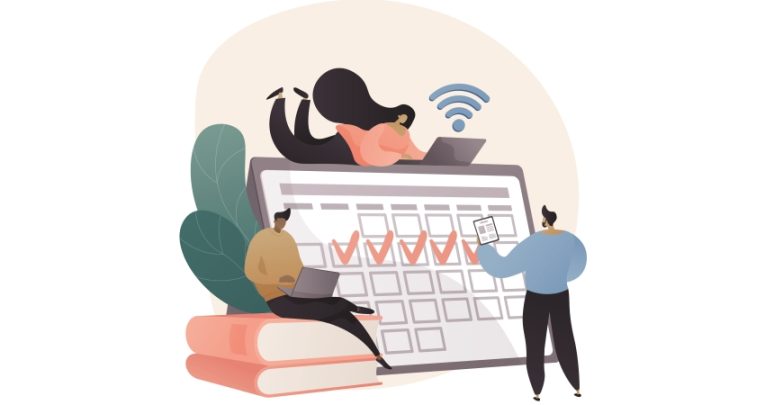Knowledge gap – Techniques for beyond surface-level teaching

Elevate students’ potential by going beyond superficial knowledge and implementing techniques that create lasting learning…

- by Teachwire

Unlock the potential of your classroom by delving beneath the surface of students’ knowledge to find out where the knowledge gap is, then employ strategies that make learning truly stick…
Why it’s important to delve below students’ surface knowledge

The questions students ask us can sometimes betray deeper, underlying knowledge gaps that we can’t afford to ignore, writes Colin Foster…
Often, when a student is stuck and asks a question, I think that the question they’re asking is more advanced than the question they should be asking.
This isn’t their fault. They’ll typically be asking about a problem they’re experiencing at that moment, which is a perfectly natural thing to do.
The teacher’s job is a subtle one. It’s not necessarily always our role to try and answer the question they’re asking us as best as we can.
There may be no such thing as a silly question, but there certainly is such a thing as the ‘wrong’ question. This is because, often, in order to help a student effectively, we have to press ‘pause’ on the question they’ve actually asked and go back to something earlier – potentially even something much more basic.
They may think this is something they already know, but it’s actually underpinning the knowledge gap they’re currently experiencing.
Two steps forward
Responding in this way can seem strange to them. They might think we’re misunderstanding the difficulty they’re having. They might interrupt us: “No, I already know that – what I’m stuck with is this.”
I think it helps to explain how we’re not failing to listen to them, but are rather trying to dig a bit beneath the surface and come at their question a bit more indirectly.
And that we believe this is more likely to address their knowledge gap – particularly in the long-term.
In this way, by taking a step back, we can more effectively enable students to take two steps forward. You can see parallels to this in other professional disciplines.
If a dentist were to spot some decay near the surface of a tooth, and rapidly ‘drill and fill’ there and then, it will likely lead to far worse outcomes later on if, in fact, there are deeper problems out of sight, a little further down below.
The danger of quick fixes
As teachers, we need to similarly drill down and find the deeper underlying causes behind the knowledge gap our students are experiencing. Failing to do so, in favour of staying with just the surface layer, is unhelpful.
If this sounds time consuming to you, then that’s probably because it is. But it’s a process built around future-proofing students’ learning, rather than only obsessing over the present.
The knowledge gaps we must address are likely to be the root causes of many superficial difficulties, meaning that dealing with them has the potential to kill many birds with one stone.
If we can secure those underlying foundations, then we can also ensure that students are less likely to keep coming back to us with more and more little issues.
Amid the busyness of a classroom, it can be hard, if not impossible to find the time needed to deal thoroughly with everything we’re presented with.
The temptation can therefore be to try and offer quick fixes instead. If that’s all we focus on – helping with those superficial problems presented to us – we’ll often manage to come up with a quick fix of some kind.
Yet while the student is quickly satisfied, they’re likely to come unstuck again almost immediately. As soon as they’re on their own, tackling similar questions again, they’ll run into a similar, but slightly different knowledge gap. And then need our help all over again.
Daring to dig
This is not only inefficient, but will also have a negative impact on the student’s self-perception. They’ll likely conclude that: “I can do it when the teacher does it with me, but I can’t do it on my own.”
This common complaint is a reliable indicator that we’re addressing the student’s knowledge gap at too superficial a level.
Or, perhaps the student concludes that they’re simply no good at the relevant subject. For one reason or another, it just doesn’t come naturally to them.
Or, they might just think that they’re generally ‘not smart’ because they fail to grasp things, despite receiving repeated help from their teacher.
At a certain point, they may even give up on asking us. If their parents can afford it, perhaps they could get a tutor in to help.
But then, there’s a good chance that all the tutor ends up doing is diagnosing and ‘fixing’ the same superficial issues, rather than daring to dig deeper into the knowledge gap.
Common difficulties
How can a busy teacher with 30 students in their classroom painstakingly address 30 different sets of knowledge gaps? Is this approach not, to state the obvious, completely unfeasible?
Indeed, in a typical classroom the teacher will have extremely limited time for performing any one-to-one teaching. But the benefit of looking for deeper, underlying knowledge gaps is that you’ll generally come across far fewer of them.
On the surface, it can seem as if every student has their hand up in relation to a different specific issue. Looked at from a different perspective, however, you may well find that really, there are only two or three different fundamental misunderstandings buried beneath the surface, serving as the root cause of almost all these problems.
If the teacher finds the time to identify what these common knowledge gaps might be, and then addresses them in small groups, or perhaps with the whole class, then considerably more progress might be made.
Smarter, not harder
Teachers can often be found rushing round their classrooms, travelling from ‘hand up’ to hand up’, overwhelmed with the sheer number of requests for help; desperately trying to manage behaviour, while also attending to students’ innumerable questions.
This can be exhausting and stressful for everyone. The teacher wishes they had another pair of hands to help them, or even that they could speak more quickly, so that they could assist more students in the same time.
It can feel like rearranging deck chairs on the Titanic while the ship is going down, instead of doing something about that iceberg.
So instead, let’s start asking what lies behind those questions that are being asked. What do these questions seem to have in common? In what ways are these seemingly different questions in some sense the same?
If there were some underlying knowledge gap responsible for 90% of these questions being asked, what might it be?
Maybe a crucially important, yet missing piece of knowledge? A connection between two things that hasn’t been made sufficiently explicit? Or perhaps a fundamental misunderstanding that’s caused students to get the wrong end of the stick?
Or, might it have something to do with students’ approach to studying – such as failing to ‘Ask three (peers) before you ask me’?
Whatever it may be, focusing on those deeper issues will be much more efficient than dealing with numerous immediate and salient questions as they present themselves.
Dive deeper
Embark on your own journey below the the surface of your students’ questions with these 6 practical strategies…
- Avoid feeling that you must immediately answer the question posed. Pause and consider whether there might be a ‘question behind the question’.
- Attempt a quick ‘root cause analysis’ on the student’s question. What might cause a student to be asking that question at this moment?
- Look for commonalities across superficially different questions that students are asking. What do these questions have in common?
- Consider addressing this knowledge gap in groups or with the whole class, rather than individually.
- Develop a culture whereby students check in books and with peers before asking you.
- Turn common or similar questions into whole-class activities for all students to think about.
Colin Foster (@colinfoster77) is a Reader in Mathematics Education in the Department of Mathematics Education at Loughborough University, and has written many books and articles for teachers; find out more at foster77.co.uk.
How to make learning stick
Teachers now have more software-assisted tools to call upon than ever when ensuring students retain key knowledge, says Emma Slater…
There are many techniques that teachers can use to deliver engaging and effective lessons. However, ensuring that key knowledge sticks can be a consistent challenge. It’s critical to identify important a knowledge gap early on, but this can be far from straightforward. This is especially the case in mixed ability classes.
Meaningful feedback
However, with the right tools at their disposal educators can set short and engaging assessments to test pupil knowledge throughout the term. This is without applying unnecessary pressure.
Users of GCSEPod will be familiar with its ‘Check & Challenge’ feature. This is a fun and engaging way of tracking progress that uses game-based activities designed to engage and motivate students.
These activities then feed into a points-based system that motivates students to reach their next academic objective. At the same time it helps them to retain key learning in the process.
You can use these results to more accurately identify where a knowledge gap is and plan your subsequent lessons accordingly.
The action required might vary considerably. However, providing students with a detailed report of their strengths and weaknesses will allow them – and you – to better prepare for their exams. They’ll also be able to plan their revision in a more focused way.
The intuitive information dashboards used in GCSEPod and similar solutions let teachers easily visualise the marks achieved by their pupils and quickly compare these against the average marks gained for each question and by the cohort as a whole.
This enables you to identify trends over the course of academic year. You can then put extra support in place, if required, at an earlier stage where it’s more likely to have a positive impact.
By intervening as soon as possible, you can ensure that pupils won’t lose their confidence and disengage with a subject. Rather, they’ll feel empowered to learn.
Targeting weaker areas
Encouraging good habits is key to ensuring that learners have the confidence to deal with a knowledge gap head on and don’t feel deflated.
Personalised learning will often be an unrealistic option for teachers with limited resources. However, with the right combination of learning software and systems, you can give pupils individually tailored support to help develop those good habits.
GCSEPod, for example, has a ‘boost playlist’ function. This will automatically generate a playlist of learning content that’s specifically intended to help a student practice only their weakest areas.
Assistance like this can give students a greater sense of control over their own learning. At the same time, it allows educators to place more emphasis on individual progress.
Teachers also have the option to call upon the aid of more formal assessments when practising exam-style situations. This can be based on examiner-authored questions that you’ve suitably mapped to students’ differing abilities and rates of progress.
The aforementioned ‘Check & Challenge’ assessment system can help in evaluating students’ levels of knowledge and understanding. At the same time they also provide scaffolded support via hints, multiple choice options and feedback statements.
The option to withhold this support and place more difficult questions in the mix will conversely ensure that you can appropriately challenge even your most able students.
Conquering the knowledge gap
The education journey tends to be an intricate one, with every learner treading their own unique path. Addressing knowledge gaps should be a priority, but it remains an often complex task.
And it’s here where technology can play a pivotal role. We can effectively ‘gamify’ students’ learning in order to boost motivation and generate insightful feedback. Variability in knowledge gaps necessitates a flexible response. However, with sufficiently detailed reports, you can empower students to navigate their own strengths and weaknesses.
Timely interventions will help to keep learners engaged and prevent losses of confidence, though the linchpin of this is to encourage good habits. Try and get into the habit of carrying out exam-style assignments and using tools such as the ‘boost playlists’ function mentioned earlier.
Ultimately, a synergy of technology, adaptable strategies and individualised support can equip students with what they’ll need to conquer their knowledge gaps, and attain a greater sense of empowerment over the course of their educational journey.
Emma Slater is senior product manager at Access Education GCSEPod










